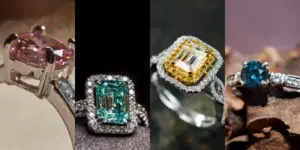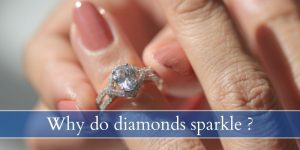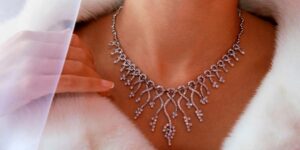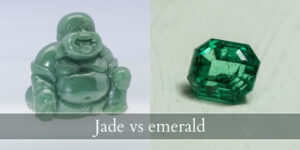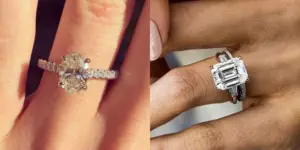If you’ve settled on a round brilliant diamond then you’ve settled on a classic, a diamond that’s bound to impress and will evoke a feeling of tradition and familiarity. After all, round brilliants are the most popular diamond shapes and have been for several decades. Having such a diamond in your engagement ring is nothing short of delightful !
So now that you’ve got the diamond, how do you want to set it ? There are several ways you can go, and there is a setting that will please most (but not all) people. After all, we are all different and you should check in with your fiancee about what style she’d like most before making the final decision. So let’s see what is the best ring setting for a round diamond, what’s the best color, what kind of metal, and, most importantly which if the 4 Cs matters the most for a round brilliant diamond.
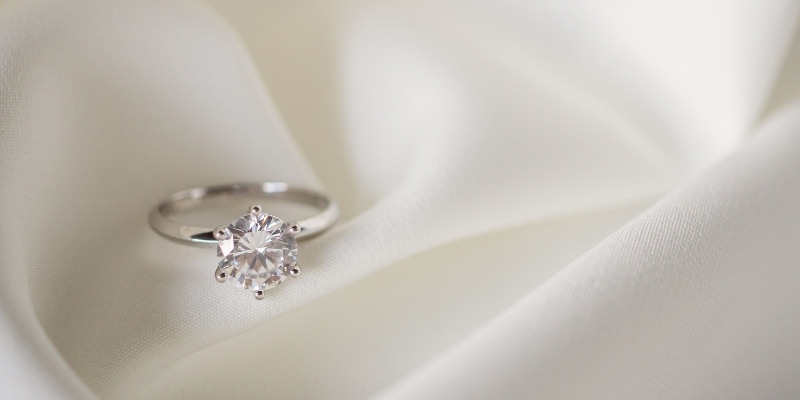
Best ring setting for round diamond
The best ring setting for a round brilliant diamond is the classic solitaire, 6-prong works best. A solitaire setting puts the diamond front and center, where it will receive all the attention it deserves. This way the diamond will get as much light as possible, will be able to sparkle as much as possible, and it will showcase any color if it is a fancy color diamond.
Assuming this is a colorless or near colorless diamond, the following points will explain why the solitaire is the best option, and discuss two more options that work well with a round brilliant.
A solitaire setting emphasizes a round brilliant’s beauty and elegance
A solitaire diamond is the classic engagement ring. It is what most people imagine when they think of an engagement ring, and it’s what the previous generations wore. So in a way it’s a comforting, familiar setting that may mean the world to someone who likes tradition and feeling connected to their roots.
Of course, the idea of a solitaire simply means a single diamond. How that solitaire is set is a whole other discussion. The classic is a prong setting, usually 6 prongs. This means 6 prongs come up from the ring shank and secure the diamond. Another option is the 4 prong setting, which still keeps the diamond secure but maybe not as much, if something were to happen to just one prong.
Examples of very beautiful prong settings are below, along with pictures
- Tiffany style setting, the prongs come up from a center point
- cathedral, the prongs also have shoulders leading down to the ring shank
- trellis, the prongs intertwine on their way up to the diamond
- basket, the prongs also have a thin metal band going around the diamond’s pavilion for extra security
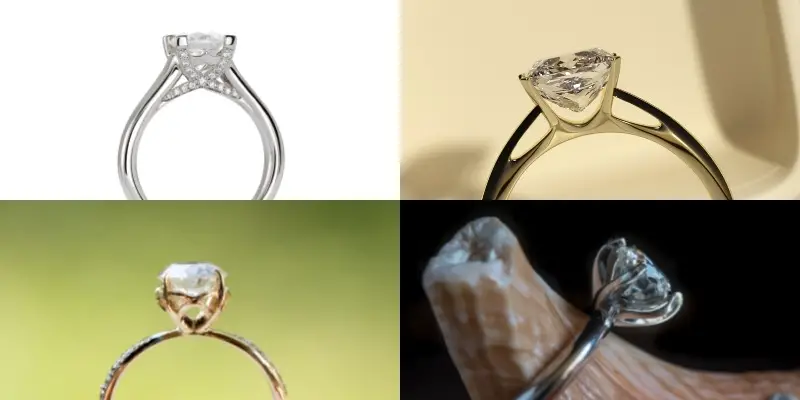
Whichever option you choose, your diamond will have plenty of light going in and out of it, and it will also be considered a high profile setting, meaning it comes high off the finger. This type of setting may easily get in the way if you have a very active lifestyle, so we recommend taking the ring off when dong anything strenuous.
Read also: Best Ring Settings For Princess Cut Diamond
What to know before choosing a solitaire setting for your round brilliant diamond
If you’re decided on a solitaire setting for your round brilliant, then there are a few other things you will need to consider. An engagement ring is made up of two things, yes, the diamond and the metal. But which diamond and which metal are always the biggest topics, right along with which setting. So let’s discuss each of these.
What metal is best for a round brilliant diamond ?
The current best metal for a round diamond is platinum, both for the ring shank and the setting (prongs). If platinum isn’t an option, then rhodium-coated white gold is the nest best thing. We recommend going for 14k since it’s stronger and more durable than 18k.
If you’re going for a more vintage or classic look then a yellow gold band is a timeless classic, a staple of the traditional engagement ring. Rose gold is not a popular or common option, but it’s definitely an option to is more modern than either yellow or white gold.
No matter the metal color you choose, the band itself is typically plain (as in no stones added and no patterns).
What color is best for round brilliant diamond ?
The best color range for a round brilliant is the G-I range. A round brilliant diamond is the most forgiving in terms of color, so you can easily go as low as an I in color, especially if you are going for a yellow or rose gold band.
A round diamond’s many facets will appear very brilliant, giving an overall whiter look. This means you don’t necessarily have to splurge on a D-F colorless diamond for this kind of diamond cut. You can if you want to, but it’s not as necessary as, say, an emerald cut or and Ascher cut which both show any and all color tint.
No matter what color you choose, your diamond will pick up a bit of the color from its setting metal. So an E diamond set in yellow gold will appear as a G in most lighting. But, this can work to your advantage, by using a white metal (platinum or white gold) for the prongs.
Read also: Best Color Diamond For Yellow Gold
What is the most important thing in a round diamond ?
The most important aspect for a round cut diamond is the cut quality. A perfect cut is rated as an Excellent cut in the GIA report, which is the most common diamond grading center, followed by IGI. What does the cut grade tell you ? It tells you:
- how good the symmetry is, that is whether the diamond’s facets are perfectly aligned or not
- whether the depth of the diamond is goo (too deep or too shallow)
- whether the culet is open or not – you want it closed
A cut grade does not tell you whether there are light leakages or if the diamond has more fire than brilliance, or a lack of contrast. Those a things you absolutely have to see in person. But the highest cut grade ensure your diamond will perform beautifully.
Cut, always got for a perfect cut. Round brilliants are very good at hiding color and inclusions. This means you can get away with even an I or J, if the band is yellow gold, and with a VS2 in terms of clarity. But do no compromise on the cut grade. Stick with Excellent.
Other settings for round brilliant diamonds
If you’re not sure a solitaire is the best setting for your round brilliant diamond there are a couple more options you can consider. Of course there are many more options but these are the ones we feel are still able to show you the beauty of the one diamond you’ve chosen, while still bringing something extra.
Halo settings add extra sparkle to a round brilliant
A halo setting is great for pretty much every diamond shape, but it’s easiest to make for a round brilliant. If done right the halo should only place the round brilliant as the center stone and draw the eye towards it, not distract from it. The stones in the halo are usually much smaller than the center stone, which is always a good idea. Your round brilliant will then stand out.
A pave band for a round solitaire adds extra sparkle to a classic
A pave band for a solitaire is the new classic. This setting means the diamond will still be a solitaire, and usually still set in prongs. But the ring shank will be diamond-encrusted, usually with a single row of diamonds with very fine, small prongs. This is called a pave setting, as in the ring being paved with diamonds.
Another option is the channel setting, where the diamonds are not set into the band, but rather the edges of the band are raised a bit around and over the row of diamonds. This makes for a thicker ring shank but some may prefer it.

I’m the main author for jewelrymaterialguide.com. I started this site after we did tons of research before our wedding and noticed that there is information about rings, jewelry, and so on that is really hard to find on the internet.

